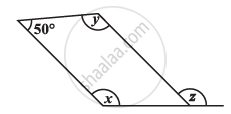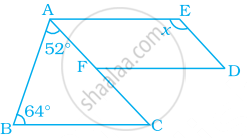Advertisements
Advertisements
प्रश्न
In parallelogram ABCD, the angle bisector of ∠A bisects BC. Will angle bisector of B also bisect AD? Give reason.
उत्तर
Given, ABCD is a parallelogram, bisector of ∠A, bisects BC at F, i.e. ∠1 = ∠2, CF = FB.
Draw FE || BA.
ABFE is a parallelogram by construction ...[∵ FE || BA]
⇒ ∠1 = ∠6 ...[Alternate angle]
But ∠1 = ∠2 ...[Given]
∴ ∠2 = ∠6
AB = FB [Opposite sides to equal angles are equal] ...(i)
∴ ABFE is a rhombus.
Now, In ΔABO and ΔBOF,
AB = BF ...[From equation (i)]
BO = BO ...[Common]
AO = FO ...[Diagonals of rhombus bisect each other]
∴ ΔABO ≅ ΔBOF ...[By SSS]
∠3 = ∠4 ...[By CPCT]
Now, BF = `1/2` BC ...[Given]
⇒ BF = `1/2` AD ...[BC = AD]
⇒ AE = `1/2` AD ...[BF = AE]
∴ E is the midpoint of AD.
APPEARS IN
संबंधित प्रश्न
Consider the given parallelogram. Find the values of the unknowns x, y, z.

Two adjacent angles of a parallelogram have equal measure. Find the measure of each of the angles of the parallelogram.
Construct ☐ BARC such that l(BA) = l(BC) = 4.2 cm, l(AC) = 6.0 cm, l(AR) = l(CR) = 5.6 cm
Iron rods a, b, c, d, e, and f are making a design in a bridge as shown in the figure. If a || b, c || d, e || f, find the marked angles between d and e
The angle between the two altitudes of a parallelogram through the same vertex of an obtuse angle of the parallelogram is 30°. The measure of the obtuse angle is ______.
In the given figure, ABCD and BDCE are parallelograms with common base DC. If BC ⊥ BD, then ∠BEC = ______.

All rectangles are parallelograms.
ABCD is a parallelogram. The bisector of angle A intersects CD at X and bisector of angle C intersects AB at Y. Is AXCY a parallelogram? Give reason.
In the following figure, FD || BC || AE and AC || ED. Find the value of x.

Construct a parallelogram ABCD in which AB = 4 cm, BC = 5 cm and ∠B = 60°.
